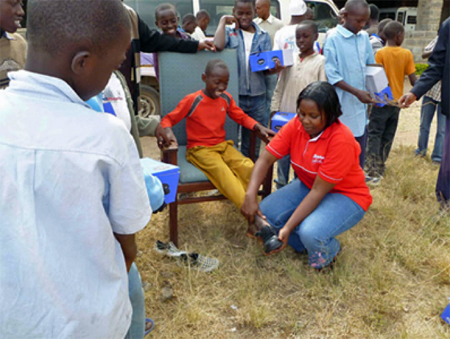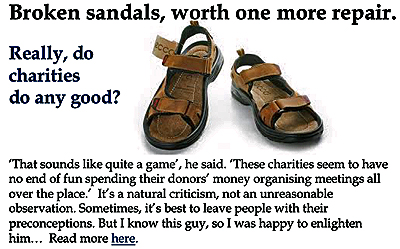|
‘Huh,’ she exclaimed with contempt, ‘that was nothing new. I already knew ‘Well,’ I replied, trying to be sagelike, ‘I know what you mean, but funnily enough I took six pages of notes, nevertheless.’ Some later articles you may like: Books by Ken.Other feature articles.
And also a special |
The Bata shoes story has been a favourite of mine for so long I’ve almost forgotten why. Recently I had a salutary reminder of it, which made me think that this story perhaps holds one of the simplest yet most profound and important messages of all, for all of us. The Bata shoes story goes like this: At the end of the nineteenth century, just as colonial Africa was opening up as a market, all the manufacturers of shoes in Victorian England sent their representatives to Africa to see if there might be an opportunity there for their wares. All duly came back in time with the same answer. ‘Nobody in Africa wears shoes. So, there is no market for our products there.’ All, that is, save for the Bata rep. He came back saying, ‘Nobody in Africa wears shoes. So, there’s a huge market for our products in Africa!’ And that’s why signs promoting Bata appear all over Africa, even in the remotest of spots. It’s why Bata’s shoes are known as the shoes of Africa. So, what’s this got to do with fundraisers? Well, it’s about how we look at things and how we see them. It illustrates why being good at looking is a quality well worth cultivating. Another instructive example for me came years back when I found myself at a fundraising conference in the UK, attending a session called ‘frontiers of direct mail’ or something similar, a panel discussion featuring many of Britain’s most successful fundraising direct marketers. Sitting next to me in the audience was a young account manager from a marketing agency of my acquaintance, just a few weeks into the job. After the presentations she couldn’t wait to deliver her verdict. ‘Well,’ I replied, trying to be sagelike, ‘I know what you mean, but funnily enough I took six pages of notes, nevertheless. She delivered me a withering look, which showed that her scorn for me knew no bounds. She didn’t have to say so, for I could sense her smugness as she flounced off thinking. ‘Fancy that, I know more than Ken Burnett.’ The fact that people see things differently was brought home again for me recently at the UK Institute of Fundraising’s 2011 National Convention where I shared the stage briefly with two splendid observers of the human condition, Giles Pegram and Alan Clayton. Afterwards we were duly sent the audiences’ evaluations of our presentation, handed in as they always are at the end of our show. I’m a bit long in the tooth now to pay much store by evaluations. They always only give part of the story and you invariably have to discount the ‘Mr Grumpy’ effect. But how can one reconcile the difference between comments such as these? One delegate wrote, ‘didn’t take anything away from session. Boring, not interactive’, while another said, ‘wow – thank you so much. Already I feel 10 feet tall and I haven’t even started yet.’ Were these people in the same room? Well of course they were. Each had seen and heard the same things, but had looked and listened differently. Someone else said, ‘it’s just common sense’, and that was clearly a criticism. Another said ‘it’s just common sense’ and meant it was great to be reminded of simple, fundamental truths. Of course we know nothing anyone does will please everyone. But equally, if we dismiss something because we think we already know better, we’ll often miss out. Instead, we should learn to look and listen better, and to think before we jump. Thanks for the lesson, Bata. © Ken Burnett 2011
Ken Burnett is a director of The White Lion Press Limited and a former chairman of the board of trustees at the international development charity ActionAid. He’s author of several books including Relationship Fundraising and The Zen of Fundraising and is managing trustee of SOFII, The Showcase of Fundraising Innovation and Inspiration. For more on Ken’s books please click here. Readers’ comments: From Kevin Baughen – exploitation. Kevin Baughen, Bottom Line Ideas. From Ian Clark – alternative version. Ian Clark, Fundraising Strategy. From Nick Hay – the dark side. Nick Hay, copywriter. |
Evaluations always only give part of the story and you
Ken Burnett’s latest book Storytelling can change the world You can visit the Online Story Bank for free, click here.
|








